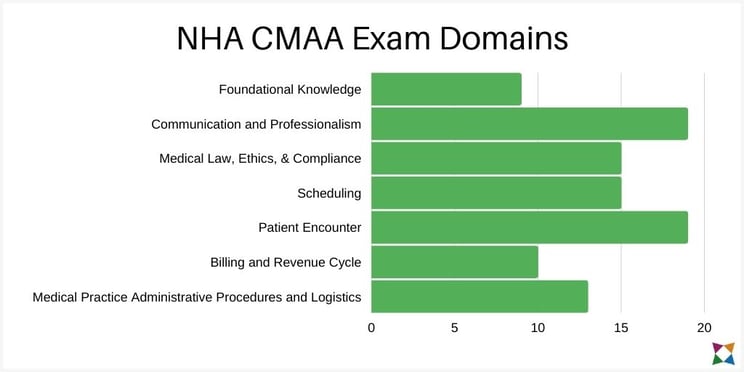NHA CMAA | Health Science | National Healthcareer Association (NHA)
What Is the NHA CMAA Exam & How Do You Prepare Students for It?
Being part of the AES curriculum team for over a decade, Kristin has experience in almost every aspect of the curriculum development process. She most enjoys problem solving, breaking down ideas, making connections for learners, graphic visualization, and typography.
If you teach medical assisting, you’ve probably heard of the NHA CMAA certification exam. This is one of the most prominent industry certifications for medical assisting, which makes it a popular topic for teachers looking for the right certification for their programs.
So what is the NHA CMAA exam? What topics does it cover, and how can you best prepare your students for it?
As a health science curriculum developer, teachers often come to us with questions like these to determine whether the NHA CMAA is a good fit for them and their programs.
In this article, you’ll discover more about the NHA CMAA exam so you can decide whether to go with it, and if so, how to prepare your students to take it. Along the way, we’ll answer specific questions like:
- What Is the NHA CMAA Certification Exam?
- How Is the NHA CMAA Exam Structured?
- What Should Students Expect on Exam Day?
- How Do You Prepare Students for the NHA CMAA Exam?
By the end of this article, you’ll have more insight into the CMAA exam so you determine how well it fits your program, and how your students can pass it.
What Is the NHA CMAA Certification Exam?
The NHA CMAA exam is an industry-recognized certification exam created by the National Healthcareer Association (NHA) to measure a student’s knowledge and skills when it comes to medical administrative assisting.
When students pass the exam, they earn a certification indicating they can work in a healthcare facility as a certified medical administrative assistant. In fact, according to the NHA, about 70% of employers require or encourage medical administrative assistants to earn certifications like these.
Because the medical industry is expected to experience even more growth in the coming years, earning certifications like these is a popular choice for those looking to start a career in medicine.
How Is the NHA CMAA Exam Structured?

The NHA CMAA exam is made up of 110 scored questions, as well as 25 pretest items the NHA uses to gather data. The scored questions fall into seven broad categories, which are referred to as “domains”:
- Foundational Knowledge (9%)
- Communication and Professionalism (19%)
- Medical Law, Ethics, and Compliance (15%)
- Scheduling (15%)
- Patient Encounter (19%)
- Billing and Revenue Cycle (10%)
- Medical Practice Administrative Procedures and Logistics (13%)
Each of these domains contains subtopics that cover a combination of knowledge students must have and tasks they must be able to perform.

Domain 1 — Foundational Knowledge
The Foundational Knowledge domain is composed of 10 questions, and covers subtopics including:
- Basic Anatomy and Physiology
- Relationship between front office and clinical processes and procedures
- Types of medical records and their components
- Types of health care organizations and delivery models
- Medical Terminology
All in all, this domain is intended to measure a student’s grasp on introductory, baseline concepts that many medical professionals should know.
Domain 2 — Communication and Professionalism
The Communication and Professionalism domain is comprised of 21 questions, and covers an array of task and knowledge-oriented subtopics that include:
- Communicating with patients, caregivers, providers, and others in the workplace
- Managing challenging or difficult customer service interactions
- Facilitating and promoting teamwork and team engagement
- Demonstrating professionalism in the workplace
- Empathy, compassion, active listening, and different communication styles
- Conflict resolution and de-escalation strategies
Altogether, this domain covers the essential skills in the workplace that ensure medical assistants know how to present themselves, handle patient interactions, work as part of a team, and more.
Domain 3 — Medical Law, Ethics, and Compliance
The Medical Law, Ethics, and Compliance domain contains 17 questions, and covers tasks and knowledge statements that include:
- Complying with laws, regulations, and guidelines
- Maintaining confidentiality and security of protected health information
- Understanding basic medical law, the Patient’s Bill of Rights, patient consent, reporting laws, and incident reporting requirements
- Following HIPAA guidelines and OSHA guidelines
Because medical administrative assistants often interact with patients, it’s essential they have a solid grasp of medical laws and ethics. After all, even one mistake in an interaction with a patient can lead to all sorts of headaches for those involved.
Domain 4 — Scheduling
The Scheduling domain is comprised of 16 questions, and covers task and knowledge statements that include:
- Determining the optimal scheduling for a patient based on factors like purpose of appointment, type of service, availability, needs, and more
- Following protocol for no-show, missed, canceled, or rescheduled appointments
- Confirming appointments, monitoring patient portal notifications, and providing patients with instructions
- Conducting pre-appointment screening and confirmation
- Verifying insurance eligibility and benefits
Scheduling is one of the primary duties of medical administrative assistants, which means knowing the ins and outs of it is invaluable. This segment of the exam will test students on their skills and knowledge so they can keep their healthcare facility running.
Domain 5 — Patient Encounter
The Patient Encounter domain is composed of 21 questions, and covers task and knowledge-oriented subtopics that include:
- Welcoming and checking patients in, as well as collecting and verifying their identification information
- Verifying and discussing insurance information with patients
- Ensuring completion of required patient intake forms
- Entering information for new and established patients
- Understanding insurance rules, the difference between copayments and coinsurance, Advanced Beneficiary Notice (ABN), electronic remittance advice (ERA), and more
Because medical administrative assistants regularly handle patient intake, it’s essential they have a strong grasp on identification and insurance information so that they can successfully check patients in. This is critical to ensuring the day-to-day operations of their facility run smoothly.
Domain 6 — Billing and Revenue Cycle
The Billing and Revenue Cycle domain contains 11 questions, and covers task and knowledge-oriented subtopics that include:
- Preparing documentation for billing
- Performing charge reconciliation and payment collection
- Knowing the phases of the revenue cycle, health care payment models, referral and insurance authorizations, and more
- Billing patients, insurers, and third-party payers
Medical administrative assistants often handle billing and payment when processing patients, which makes knowledge of this domain critical. By testing students on this knowledge, the CMAA exam ensures students can effectively handle the revenue cycle at their facility.
Domain 7 — Medical Practice Administrative Procedures and Logistics
The Medical Practice Administrative Procedures and Logistics domain is comprised of 14 questions, and covers task and knowledge statements that include:
- Managing and reviewing medical records to ensure they are secure and complete
- Performing financial procedures (like financial reconciliation) as well as opening and closing procedures (such as checking messages, turning equipment on and off, and preparing daily medical records)
- Verifying contents of deliveries and managing inventory of administrative supplies
- Understanding facility policies and procedures, filing systems, types of letters and templates, basic computer skills, data storage and back-up requirements, and more
This domain covers many of the regular logistical tasks and duties a medical administrative assistant will be expected to perform at their facility. By testing these skills, the exam measures whether a student knows the role and the proficiencies they will need to fulfill it.
What Should Students Expect on Exam Day?
After creating a free NHA account, students can submit an application for the CMAA exam through their account portal, and choose the date and location where they want to take the test. Generally, students choose whether to take the exam at their school, at a PSI testing center, or via remote proctoring from wherever they want.
Come exam day, students will have 2 hours and 15 minutes to complete the exam. Often, the exam is administered via an online portal, but it could also be given on paper depending on the circumstances of the testing site.
If your students take the CMAA exam online, NHA will typically post their results two days after scoring the tests. Students can find their test results on their NHA account page.
How Do You Prepare Students for the NHA CMAA Exam?

NHA offers dedicated test prep materials to help students prepare for the CMAA exam, which you can find on the exam page on their website. These materials include an online study guide as well as a practice test that students get up to six attempts to complete.
If you leverage these materials well, your students will have a firm idea of what challenges wait for them on the CMAA test, and will be better equipped to handle them come exam day.
However, NHA’s test prep materials are only one step toward ensuring your students pass the CMAA exam. After all, while these materials do a good job of prepping students for the exam specifically, it is essential that students have a strong body of foundational knowledge to work with before using them.
In other words, NHA’s test prep materials are no replacement for a solid medical assisting curriculum. Instead, these two resources work best when used in conjunction with one another.
Using them together, the curriculum provides your students with the essential healthcare knowledge they need to have, while the test prep materials take them the extra few steps toward the end to ensure they pass. With this method, some schools have even achieved a 100% passing rate on the CMAA exam, compared to about 70% before.
If you want to prepare your students for the CMAA exam in the most effective way possible, you’re better off using both a dedicated curriculum and NHA’s test prep materials alongside one another.
Prepare Your Students for the NHA CMAA Exam with HealthCenter21
In this article, you’ve learned about the CMAA exam’s structure, topics, and how best to prepare students for it. The bottom line is, using NHA’s test prep materials alongside a comprehensive curriculum will cover all of your bases and ensure your students are well on their way to passing their exams.
But what curriculum options are out there to help you teach your students these foundational concepts they need? Hundreds of health science instructors across the country would recommend HealthCenter21 to help your students succeed both on their exams and in their future careers as CMAAs.
"I gave the CMAA exam before starting with HealthCenter21 and the students really struggled. With HealthCenter21 I'm at a 100% pass rate."
Janet Fabra
Royal Palm Beach High School, FL
HealthCenter21 provides ready-to-use lesson plans, projects, assessments, and more, all aligned directly with the NHA CMAA exam. Check out this CMAA certification success guide to see how you can use HealthCenter21 to ensure your students get certified:


